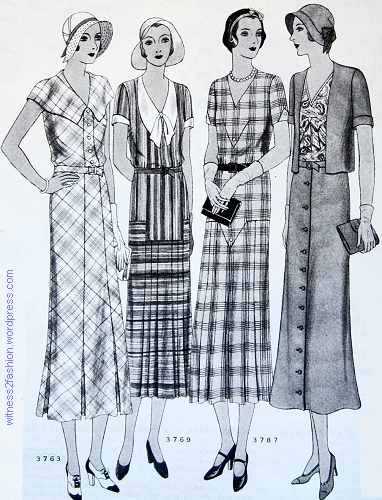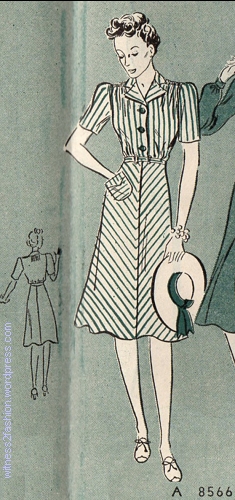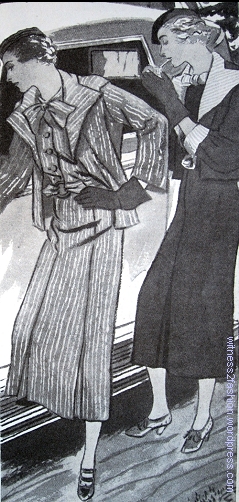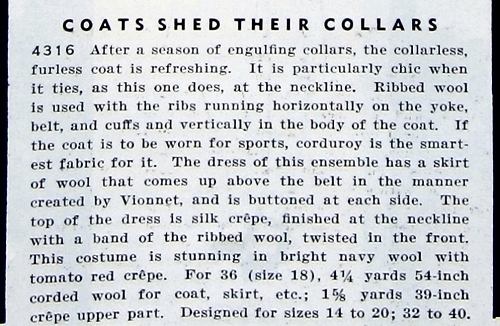Fifty years ago, I saw this 1930’s photo of actress Gertrude Lawrence in a striped suit. The creative use of striped fabric struck me and stayed in my memory. The joy of these nineteen thirties’ dresses is the way that a striped fabric is turned in different directions — horizontally, vertically, on the bias — to create the interest of the design.
Simple Striped Dresses
Striped dresses in many variations appeared throughout the 1930’s. I’m not talking about dresses that simply use striped material, charming as these are:

Left: Stripes cut on the bias. Butterick patterns from The Delineator, 1934. Left, #5599 from June. Right, #5767 from July. This fabric was probably printed with diagonal stripes and used on the straight grain.
I’m trying to imagine jumping over the net in one of those tennis dresses. Actually, #5599 isn’t so simple; getting stripes to match and form chevrons on the bias takes patience.
Striped dresses were usually summer wear. This one is punningly named after Lucky Strike Cigarettes.
The dress below is a three piece set: blouse (with or without sleeves) plus skirt and shorts.
The stripes are all cut simply on straight of grain here, but pattern matching would make cutting and assembly more difficult! Matching stripes is a challenge for the dressmaker.
Stripes in Different Directions
The dresses that delight me turn the stripes in different directions.

Butterick pattern #3769, The Delineator, April 1931. [Two of these early 30’s dresses have both a low hip and a natural waist.]

Pattern #8583 has a slenderizing center front panel, Butterick Fashion News, September 1939. It came in sizes 34 to 52.
A simple dress with bias skirt and playful pocket:
Sometimes the interest comes just from the flattering contrast between a horizontally striped yoke and a vertically striped dress.

Butterick pattern #5201 makes a striped cruise dress, January 1934, The Delineator. The horizontally striped pocket flaps carry the yoke design to the skirt.
Here, the yoke is on the bias, and echoes the diagonal lines of the pockets:
When the yoke continues into sleeves, there is added interest:

Horizontal stripes on yoke, pockets, and belt; vertical stripes on the body of the dress. Butterick Fashion News flyer, March 1938. By 1938, the center front zipper was no longer news.
This yoked dress and jacket combination (at right) has an interesting dress, too.

Jacket dresses from February, 1935. The bias stripes appear to change direction as they follow the sleeves. Butterick pattern #6074.

This dress with chevroned stripes goes under coat # 6074 . It also has “yoke and sleeves in one.” Butterick pattern from February 1935. The Delineator.
The ensemble below is pretty straight forward, but the lapels, bow, and belt turn the stripes in a different direction:
The play of stripes also appeared in thirties’ evening wear:

Striped evening dress, Butterick, February 1934; striped gown and matching jacket, Butterick, July 1934. #5780 has beautiful, complex striped sleeves.
Advanced Play with Stripes
But the play of stripes gets really interesting when used as the focus of the design.

The more complex, the more fun — or at least, the more challenging for the dressmaker. Butterick #4089, October, 1931.
“The zigzag dress to the left is made of muffler woolen, soft to touch, and in wonderful two-tone colorings. Leather belt and buttons, and a scarf barely peeking out above the collar.” — Ladies’ Home Journal, September, 1936.
This one has contrasting shapes inserted in the sleeves, a tucked bib, and buttons in graduated sizes.
Stripes were often used on “bib” dresses:

“Housedresses” from December, 1931. Butterick patterns. The one on the right was actually a “pull on” dress with mostly decorative buttons.
Ribbed wool or corduroy was also used for a more subtle play of stripes:

Butterick Pattern #4316 for a dress with silk crepe bodice and skirt of ribbed wool, with matching coat. Contrast yoke, bow, cuff trim, and belt. The Delineator. February, 1932.
Corduroy was also suggested for this lightweight coat:
Bold stripes give lots of “Bang for the buck.”
Floral stripes were popular in 1938.

What a difference the stripes make: Two versions of Butterick #8557, Butterick Fashion News, September 1939.
Does anyone feel inspired to rework a basic pattern — by playing with contrasting stripes? Maybe a sewing group would like to have a “stripe challenge.”



















Each one more beautiful than the next! I love stripes and love the amazing details here, especially Butterick 4089. Since this was the Depression era, it occurs to me that this kind of fabric manipulation was a way to make something special out of inexpensive fabric, like corduroy.
And it’s an attest to the skills of the home sewer, that Butterick could sell those patterns with inset plackets and chevron stripes! Though I don’t imagine anyone under 5/3 who wasn’t stick thin wearing all that patterning very well. Thanks for this!
Nancy N
I agree — work like this calls for skill and patience. I try to remember that Butterick was aimed at the kind of woman who could have her clothes made by her town’s dressmaker, not necessarily by herself. You didn’t have to be very high on the social scale; my aunt had a friend — a war widow — who made some of my clothes. It took me a while to realize that it was her way of giving the friend financial help without it changing their status as equals. And the dresses were perfectly made.
Wow, how touching. And so kind! I bet those dresses were lovely. My grandma made everything, she was a terrific tailor. Adorable dresses for my sis and me. Mom told me during the depression, grandma made herself a “good” suit out of one of grandad’s worn out ones. She said that the pants were fuller in those days, leaving plenty of material to make a gored skirt. Grandma was 5/3 and 130, and granddad was 5/11 and 175. Quite a bit of cutting down there!! Wish I had a pic of it now.
These are beautiful patterns, aren’t they? I love the different stripe directions and there are so many complex designs. Yes, I would like to have a go at some of these ideas…bet it could be quite frustrating though!
I absolutely love designs that allow for interesting stripe placement! So many inspirational sketches in this post – thank you!
I’m an obsessive stripe/print matcher and I find myself buying fabrics that contain “stripes” in some form – even if it’s a polka dot. Makes for extra long projects though because it takes me probably twice as long to cut something out as it does to actually sew it.
Getting it right is so satisfying! Considering manufacturers’ switch to the least labor intensive designs possible, the days when mass market sportswear included shirts that played with stripes on collars, cuffs, pockets and plackets are probably gone forever.
A stripe challenge might produce some very interesting apparel! Interesting post…
I inherited McCall 8611 (1936) from the estate of a great aunt. I wish she’d left me the dress, too, but at least I got the pattern!
Let us know if you make it!
This is so beautiful and so inspiring! Thank you so much!
Pingback: 1938’s Fashionable Floral Stripes |